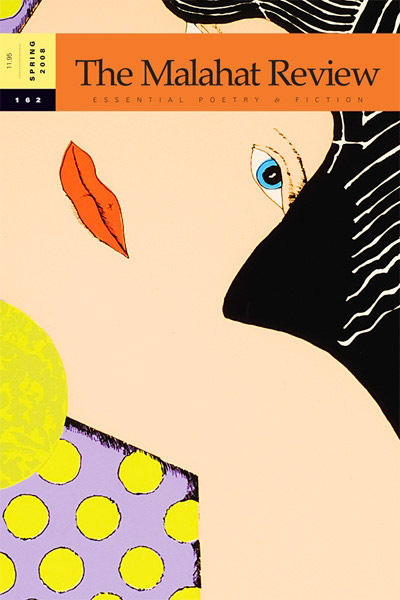Issues
Our Back Pages
Issue #162
Issue Date: Spring 2008
Editor: John Barton
Pages: 112
Number of contributors: 26
Buy Issue 162: Print Edition

Do you know that feeling when you go to bed physically well but wake up in the middle of the night—you know something is wrong, but you’re just waking up so you’re in a bit of a fog. And then, gradually, you realize it’s not what you thought. It’s not a thing out there that woke you up, but in here. There’s a rising chill up your spine and something funky is happening in your stomach. Then realization cuts through the fog of dreaminess and you’re up and running for the bathroom because you’ve figured it out: you’re going to puke! You know that feeling? After reading the Spring 2008 issue of Malahat, I found myself trying to remember the last time I felt it. It wasn’t that the issue itself nauseated me; I was inspired by the first story, “Puke Diary,” by Anne Fleming. In 2008, we were just beginning to understand the power of cat videos on YouTube, and the story begins with the literary equivalent of a cat video. The first entry of the “Puke Diary” is “The Private Puke Diary of Sarah the cat” which proceeds as you might imagine it would: “blup. Into shoes. Felt better.” If that’s all the piece was, it would be a cute joke and nothing more. But the next entry changes the game. It is a different diary, composed by “Douglas ‘Collie’ Collins” and although it involves the feeling I mentioned (a direct result of Christmas Cake), the entries take a turn and also become about the young writer’s disappointment in realizing the truth about Santa Claus. Then there is “Baby Hal’s” diary, written by his mother, and “The Private Private Extremely Private Private Diary of Emma Macintosh-Collins” in which the initiative for these puke diaries is revealed. Emma writes that her dad, on a road trip, suggested that it would be funny if they all wrote puke diaries: “It’d be, like, our lives, through puking.” When you think about it, it makes sense, since those moments of intestinal trauma are often associated with memorable events. From this point on, and through the following diaries, the story becomes much more about the “lives” and less about the “puking” and that’s what gives the story its real power.
Another “physical trauma” piece is Kathy Mac’s poem “Cutter Ants,” which makes about the best use I’ve seen of an epigraph. The quotation that sets the tone of the poem is about the way that people who self-injure can become upset when their scars fade. The poem then is almost a found poem from a biology textbook, in which the behaviour of cutter ants is described. But those simple descriptions take on a new kind of power in the light of the epigraph, as when she says: “Daily, the number and kinds— / incision, slit, slice, notch, section— / index the colony’s success.”
Anne Simpson’s poem, “Aslant,” looks at things sideways; Maleea Acker finds “The Almond in the Earth”; Lynn Davies gets on her knees “at the Strawberry U-Pick”; and Patricia Young explores the sexuality of alpine mummies and Sumatran girls in “Iceman” and “Dildo.”
The issue ends with a story by D.W. Wilson called “The Elasticity of Bone” in which a young man challenges his father in a judo tournament. Wilson is adept at moving from description to action and from memory to the moment, so his story has a thrilling energy fuelled as much by his technical skill as a writer as by the fight itself.
—Jay Ruzesky









